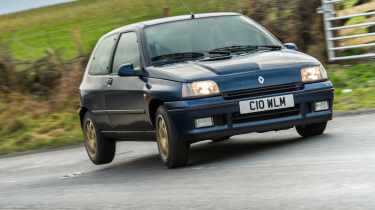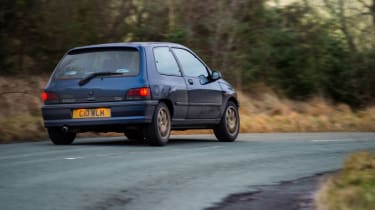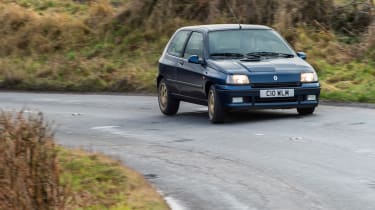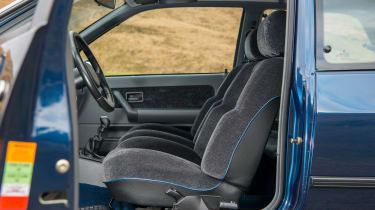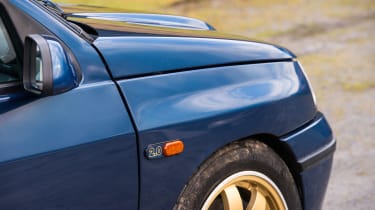Renault Clio Williams - review, history, prices and specs
The Clio Williams was the first hot hatch to put the legendary Peugeot 205 GTI in the shade
Succession is always intriguing. Sometimes the master won’t go quietly, doesn’t have to, and so plays on. Sometimes the handover of power is crushingly unsentimental, final.
It’s the early 1990s, and the 1.8-litre Clio 16v has tussled for hot-hatch glory with the ageing Peugeot 205 GTI 1.9. It’s a better car by many objective criteria, but not a convincingly faster one, and in the eyes of many the GTI still holds the crown. Yes, you could argue that Renault already holds the balance of power with the Clio’s forefather, the 5 GT Turbo. You’ll find a few at evo who believe that, and they’re not necessarily wrong, although I can’t agree with them.
> Click here for our review of the Audi RS2
It took a truly special car to convincingly wrest supremacy away from Peugeot, to really bury the old-timer and to refine the class in the process. That car was the Clio Williams – so much more than simply a Clio 16v with an extra 200cc.
In Detail
Sold with the compelling marketing tinsel of an F1 team association, the Williams was actually an homologation special in the familiar mould. It was built because Renault Sport wanted to go rallying and the class maximum displacement stood at 2 litres. Given this was still the era of homologation into classes A and N – oh how we all miss that – Renault simply had to build 2500 road cars to qualify, although it would eventually build many more.
More reviews
Naturally, Renault Sport did a thorough job. The suspension uses a reinforced front subframe borrowed from the Clio Cup racer, plus uprated springs, dampers, rear torsion arms and thicker anti-roll bars. The track is increased by 34mm and the 7J Speedline alloys are half an inch wider than the 16v’s, and unforgettably gold. Obviously. The gearbox is stronger, too, with revised ratios. There was just one exterior colour offered for the first generation of Williams – ‘449’ Metallic Sports Blue – and the cumulative effect of body (already blistered of arch, front and rear, and bulging of bonnet from the 16v), paint and those wheels is as close to hot-hatch perfection as I think you could ever hope to get. It is a small car, with a wheel pushed to the very extremity of each corner; a little shorter, slightly wider and significantly lower than a Clio 172 or 182; so tiny as to be incomparable with a current RS Clio.
> Click here for our review of the Renault 5 Turbo
Now as then it’s the engine that shines the brightest, producing 148bhp at 6100rpm and 126lb ft at 4500rpm. Codenamed F7R and developed from the 16v’s 137bhp F7P unit, it features a longer stroke and bigger bore size, and benefits from a stronger crankshaft (borrowed from the diesel Clio) plus new pistons, camshafts and conrods, with bigger valves and a lightweight exhaust manifold. Granted, those numbers today seem almost comically weak for a frontline supermini hot hatch, particularly the lowly rev-peak for maximum power – it may be naturally aspirated, but it’s hardly a ‘screamer’. Yet, as ever, context paints an altogether different picture: the Williams weighs just 981kg (marginally more than the 16v) and the big benefit of the new engine over the regular 1.8-litre lump was torque; not just the peak, but the fact that 85 per cent of it arrives from 2500rpm.
I should also say right now that this left-hand-drive example is ‘0001’ – the car that sat idle in the Williams Grand Prix Collection for many years and is now owned by Renault UK. With just over 2000 miles on the clock it looks, smells and drives like a new car. It really is like stepping though a time portal back into 1993, to be one of those lucky 390 souls in the UK who handed over £13,275. If I’d thought about it in advance I could have brought The Orb along on cassette, and maybe acquired some baggy, shiny suit from a charity shop, which I then could have stored in the Williams’ curious zip-up suit holder that’s attached to the underside of the parcel shelf. Clearly French rally drivers liked to arrive at the next time control in some style.
Actually, there’d be no ‘Little Fluffy Clouds’ today (just the Welsh variety scudding over our heads), for when I lift the elephant-hide-textured plastic lid in the centre-console, the single DIN slot is deliberately empty – there’s no radio-cassette in this car.
Otherwise, it’s fairly plush in a ’90s, French way, an interpretation of automotive luxury utterly alien to the current widely held notion of it. The deeply bolstered sports seats are squishy in the traditional French style and covered in a curiously soft velour material, the random black pattern of which makes them look threadbare even when brand new – as these effectively are. An oversized blue ‘W’ is imprinted into the backrest. Renault Sport was not subtle with the blue theme: there are blue seatbelts, a filet of blue atop the gearknob, imprinted with the layout of the car’s five forward gears and reverse, and blue faces for the Sagem dials, including a trio of oil-obsessed instrumentation at the top of the centre-console: level, temperature and pressure. Why don’t manufacturers do this anymore?
Nineteen-nineties man would have felt smug in here, pinballing down a B-road, the Clio’s solidity a notable improvement on what the 205 offered. I do too, until a little later when the front wheels lock momentarily over a damp crest and I remind myself with some urgency that ABS was not offered on the first Williams, and that the squishy pad in the centre of the steering wheel is for decoration.
| Renault Clio Williams (1993) | |
| Engine | In-line 4-cylinder, 1988cc |
| Max power | 148bhp @ 6100rpm |
| Max torque | 126lb ft @ 4500rpm |
| Weight | 981kg |
| Power-to-weight | 153bhp/ton |
| 0-60mph | 7.6sec (claimed) |
| Top speed | 134mph (limited) |
The Drive
The essence of our initial few miles through the Welsh mountains defines what currently makes ’90s performance cars so compelling: the Williams is defiantly mechanical in spirit, but also competent to a degree even a newly qualified motorist of today could relate to. Its power-assisted steering has surprising weight for anyone weaned on modern machinery but avoids the clumsy heft of a 205’s unassisted rack at low speeds, and its general manners are at least in the same orbit as cars from the past decade. That’s not to say that it doesn’t creak: it does, even this example, in inimitable French hot-hatch style, from the very moment you’re underway.
That 1988cc four-cylinder engine is familiar from the moment the starter churns – a flare of revs overlaid with belt whine, the slightly lumpy idle with that soft whur-whur-whur backbeat. Anyone who’s ever driven a naturally aspirated Renault Sport Clio could identify it blindfolded. For a car to be an icon it must have its own signature, and sound is often one of the elements that makes up that unique scrawl. The Williams is no exception.
> Click here for our review of the Peugeot 208 GTI by PS
The engine’s presence never fades. There’s a harmonic in the mid-range that sends a fizz through the shell and the seat, and an under-bonnet chuckle on the overrun not dissimilar to that of a later Renault Sport Clio as the revs fall back past 5000rpm. The gearlever vibrates and moves markedly with driveline shunt. This all reinforces the notion that the Williams is a tiny car with a mightily powerful engine, the sinews of its muscular delivery bulging the bonnet to the point of buckling the metal like the Hulk’s sacrificial T-shirt.
It is fast. Fast enough. It revs out raucously and keenly, if not dazzlingly so, but it’s the mid-range muscle that had journos of the time really wowed. Today we take for granted the immediate low-down shove of modern turbocharged performance engines, but back then the Williams’ ability to snap forward at 3000rpm must have seemed very special when combined with its energetic final 1500rpm.
The moment I begin to drive it I want to drive it quickly, until I’m grinning like a maniac and crouched forward around the wheel in a weird, legs-splayed, Tazio Nuvolari-drives-Auto Union style. In truth, part of that posture is because of a driving position that tilts the wheel with a pronounced forward rake. It’s a stretch to reach the top dead centre with my palms, and combined with the weight of the steering and the size of the wheel it means that the Williams is not a car I can drive from just my wrists; I’m working the wheel, moving my grip to feed the car into a corner, not flicking it. This is also precisely the moment that the Williams truly comes alive. It seems to almost visibly fizz with energy at the prospect of a challenging road, the more lumpy and awkward the better.
The Williams’ approach to enthusiastic cornering almost exclusively involves just three wheels. The fourth – the wheel on the rear axle that’s on the inside of the curve being taken – gets a welcome respite, and hangs for a fleeting moment in thin air, spinning with futility. This tripod is masterfully effective, forming a stable platform from which the car can summon terrific grip and poise. In fact, it’s not so much the ultimate grip level that betrays the car’s age, but its initial reaction to a turn. The whole car is much softer than a 182 Cup, let alone a current 220 Trophy. There’s more give. That body roll, the moment during which the car settles, detracts from the immediacy of the driving experience deemed so essential in modern sporting machinery, but it also communicates so much about what’s happening at the tyres’ contact patches.
It’s the difference between studiously reading a book’s foreword and every page, and skipping straight to the main event in chapter five. You learn so much more about what’s going on around the main characters, not just what actually happens. It also allows the Williams to soak up even the nastiest of cambers and holes while refusing to be nudged off line. As the miles betwixt hedgerows pass, the Williams feels a more sophisticated, matured product than the fabled Peugeot. That’s not to say it’s all grown up and lacking in humour, but whereas the flighty, lighter 205 tip-toes down a road always on the brink of oversteer that demands to be correctly handled, the Williams works its rear axle in a more precisely measured fashion; it will swing around, but it’s never what you might term ‘wild’.
Controversy stalked the Williams like it often does with icons, automotive, human or otherwise. Having made a brilliant car, and with the realisation it had a lucrative success on its hands, Renault couldn’t resist making a Williams ‘2’ in 1994. Almost identical in specification, including colour, but based on the phase-two Clio Mk1 and devoid of a numbered plaque.
> Click here for our review of the Renault Sport Clio 220 Trophy
Owners of the original were not happy, their initial investment now looking decidedly shaky. There was even an action group set up, and the situation left an unpleasant fug of exploitation clinging to the car, a lesson to manufacturers that promises could not necessarily be broken. Even so, in 1995 Renault made a third instalment, this time in Monaco Blue, a lighter shade of the familial hue, and with ABS. Again, it wasn’t numbered. In total, 12,100 Clio Williams were made.
By now, the original great era of the hot hatch was fading fast, soured on car crime, insurance costs and changing fashion. In the mid-’90s manufacturers became obsessed with coupes, and hot-hatch residuals collapsed. Many were thrown into the scenery; plenty have since corroded past the point of no return.
That doesn’t apply to 0001, of course. It inevitably sits atop a pricing structure that has climbed spectacularly in recent years. And right now it’s time to take it back to its home, or the warm, dry confines of its covered transport that awaits, to be precise – a rig that’s significantly further away than planned due to some ‘misinterpretation’ of the map. Ahem.
> Click here for our Renaultsport Clio 182 buyers guide
With the rain beading rapidly up the heavily detailed windscreen to the point where the wipers are barely necessary, the Clio zips along in the darkness, past the faint silhouettes of distant mountains, expansive reservoirs and the distracting mirrors of roadside standing water. Just the Williams and me, mile after mile, the little car with the big heart, not intimidating despite the surroundings, its rarity or its value, and as ever demanding to be driven with a joie de vivre that strikes right to the absolute core of what driving for fun is about.
Perversely, it gives me time to think. The Clio Williams qualifies effortlessly for ‘icon’ status because it set a new performance benchmark in the hot-hatch arena, because it successfully completed the succession from the hitherto imperious 205, and because its visual presence carries an indefinable gravitas that requires no explanation. It’s also brilliantly entertaining to drive.
But I think for me, somewhere on this dark, wet road in Wales, what really makes the Williams an icon is that even now, in 2017, it’s able to accelerate, brake, turn and corner at a level that’s genuinely not far off the current crop of supermini tearaways. For a 24-year-old car, that’s exceptional. In 1993 it must have been a thing of wonder.

